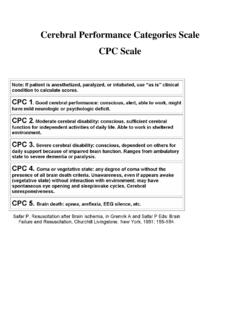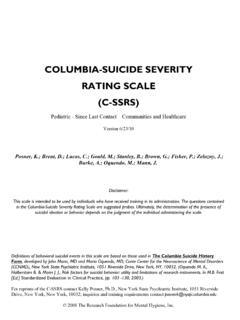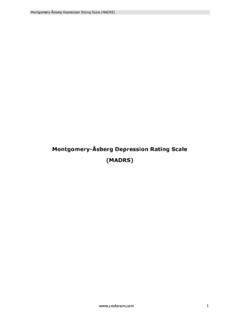Transcription of MAJOR AND MINOR SCALES - University of Tennessee
1 Dr. Barbara Murphy University of Tennessee School of Music MAJOR AND MINOR SCALES HALF AND WHOLE STEPS: half-step - two keys (and therefore notes/pitches) that are adjacent on the piano keyboard whole-step - two keys (and therefore notes/pitches) that have another key in between chromatic half-step -- a half step written as two of the same note with different accidentals ( , F-F#) diatonic half-step -- a half step that uses two different note names ( , F#-G) chromatic half step diatonic half step SCALES : A scale is a stepwise arrangement of notes/pitches contained within an octave. MAJOR and MINOR SCALES contain seven notes or scale degrees. A scale degree is designated by an Arabic numeral with a cap (^) which indicate the position of the note within the scale . Each scale degree has a name and solfege syllable: scale degree NAME SOLFEGE 1 tonic do 2 supertonic re 3 mediant mi 4 subdominant fa 5 dominant sol 6 submediant la 7 leading tone ti MAJOR SCALES : A MAJOR scale is a scale that has half steps (H) between scale degrees 3-4 and 7-8 and whole steps between all other pairs of notes.
2 1 2 3 4 5 6 7 8 W W H W W W H TETRACHORDS: A tetrachord is a group of four notes in a scale . There are two tetrachords in the MAJOR scale , each with the same order half- and whole-steps (W-W-H). Therefore, a tetrachord consisting of W-W-H can be the top tetrachord or the bottom tetrachord of a MAJOR scale . For example, G-A-B-C can be the bottom tetrachord of the G MAJOR scale or the top tetrachord of the C MAJOR scale . MINOR SCALES : There are 3 forms of MINOR SCALES : natural, harmonic and melodic. Natural MINOR scale -- a scale that contains half-steps between 2-3 and 5-6 scale degrees (the natural form). 1 2 3 4 5 6 7 8 W H W W H W W You can think of the natural MINOR scale as the 6th degree to the 6th degree of a MAJOR scale . As with the MAJOR scale , each note has name/solfege syllable. The names/solfege syllables of the third, sixth and seventh degrees are different from MAJOR .
3 scale degree NAME SOLFEGE 1 tonic do 2 supertonic re 3 mediant me 4 subdominant fa 5 dominant sol 6 submediant le 7 subtonic te Harmonic MINOR scale -- a form of a MINOR scale with half steps between 2-3, 5-6 and 7-8. Its unique interval is that between 6-7 -- the whole plus half step (or augmented 2nd). 1 2 3 4 5 6 7 8 W H W W H W+H H It can be thought of as a natural MINOR scale with a raised 7 scale degree . The 7th scale degree is raised to have a leading tone in the key; makes V-i sound as we expect. It is called the harmonic MINOR sclae since the seventh scale degree is changed to make the harmony i-V-i sound correct. 7th scale degree is called leading tone (ti) -- just as in the MAJOR scale . scale degree NAME SOLFEGE 1 tonic / keynote do 2 supertonic re 3 mediant me 4 subdominant fa 5 dominant sol 6 submediant le 7 leading tone ti Melodic MINOR scale - has 2 forms: ascending and descending.
4 This type of MINOR scale is called "melodic" because is it easier to sing; there is no augmented 2nd interval. The ascending form has half steps between 2-3 and 7-8. 1 2 3 4 5 6 7 8 W H W W W W H Its bottom tetrachord is the same as that from the natural MINOR scale , and the top tetrachord is the same as that from the MAJOR scale . It can be thought of as harmonic MINOR with a raised 6th. The 6th scale degree is raised to alleviate the W+H step interval between 6-7 in harmonic MINOR . The 6th scale degree is the submediant (la); the 7th scale degree is the leading tone (ti). scale degree NAME SOLFEGE 1 tonic do 2 supertonic re 3 mediant me 4 subdominant fa 5 dominant sol 6 submediant la 7 leading tone ti The descending form: 8 7 6 5 4 3 2 1 W W H W W H W has half steps between 2-3, 5-6 (the same as the natural MINOR scale ) The 6th scale degree is the submediant (le); the 7th scale degree is subtonic (te).
5 scale degree NAME SOLFEGE 1 tonic do 2 supertonic re 3 mediant me 4 subdominant fa 5 dominant sol 6 submediant le 7 subtonic te scale RELATIONSHIPS: MAJOR and MINOR SCALES may be relative or parallel. Relative MAJOR and MINOR SCALES share the same key signature but start on different notes. ( , C MAJOR and a MINOR ) Parallel MAJOR and MINOR SCALES have the same starting note but different key signatures. ( , C MAJOR and c MINOR )










